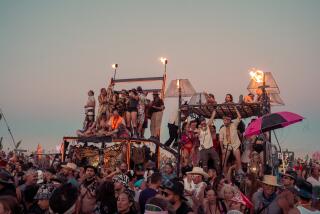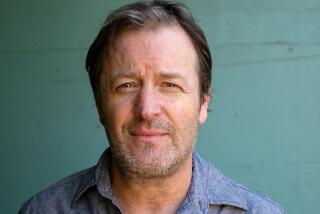It’s a mountain of work and a crazy idea at that but this family has long been dedicated to the job.
- Share via
CRAZY HORSE MOUNTAIN, S.D. — If what Casimir Ziolkowski does for a living seems a little bit . . . well . . . crazy, try to think of it as simply carrying on the family business. A sort of Ziolkowski and Sons (and Daughters) Inc.
Of course, how many family empires have been carved from a patriarch’s dream of turning a 600-foot mountain into the world’s largest statue, a model of the 19th-Century Sioux chief Crazy Horse on horseback that would dwarf the nearby presidential monument at Mt. Rushmore?
Sculptor Korczak Ziolkowski, a Polish-American who assisted in the Rushmore project, had only $174 in his pocket and a few sticks of dynamite when he agreed to a request from Indian leaders and began work on Crazy Horse back in 1948.
Legacy Continues
A marriage, 10 children, 13 grandchildren, $5 million in contributions and 8.3 million tons of rock blasting later, the Ziolkowski clan is still hard at work--even though Korczak died in 1982 at the age of 74.
Casimir started helping his dad dynamite the mountain when he was 7 years old. Today, at 35, his office is a wind-swept ledge where a small team of engineers are shaping a forehead for the Indian leader with pneumatic chisels and a new jet-powered blowtorch that burns away flecks of granite at temperatures approaching 4,000 degrees.
“This is normal to me,” he says. As for his four children: “They’re going to be brought up just like I was.”
Down on the ground, Casimir’s sister, Monique, does all the measurements and calculations needed to pinpoint where to blast and cut. Another sister, Ann, directs the Indian historical museum, which is part of a tourist complex that the family runs to bankroll work on the mountain.
Sister Marinka makes paintings and sculptures for the gift shop, sister Jadwiga manages the restaurant, sister Dawn supervises all the mail solicitations, brother Mark cuts timber on the property and brother Adam takes care of the farm. Korczak’s 63-year-old widow, Ruth, oversees the entire operation.
Refuse Public Funding
To Americans hooked on instant gratification, progress on the mountain might seem glacial. But then again, Rushmore took 14 years to complete even with large injections of federal cash and a work force of 60. Crazy Horse, which will be nine times taller than Rushmore, has never employed more than seven workers at a time. The Ziolkowskis, citing a distaste for bureaucracy, have declined all offers of public funding.
After four decades--longer than the life span of the real Crazy Horse, who was murdered at 33 not long after leading the charge against Gen. George A. Custer at Little Big Horn--only the roughest of features are discernible.
It’s like watching an agonizingly slow and tantalizing striptease, a kind of bump and grind in hard rock. One year the bare outlines of the horse’s mane take form. Another year you can sort of make out an arm. Now comes the forehead and hopefully, by next year, the rough form of a nose and upper lip.
Hard to believe, but technology is quickening the pace of the work. Computer experts are devising a sophisticated three-dimensional mapping program for the mountain to shortcut thousands of measurements and maximize the efficiency and precision of drill work. Technology and money permitting, there’s even talk of someday using powerful lasers to burn features into the rock.
A Labor of Love
Still, there’s no timetable for completion. Ruth doubts she’ll see it in her lifetime and Casimir’s not even sure he’ll see it in his. That doesn’t faze either of them. “When you grow up with something, it becomes a part of you,” Ruth explained. “I wouldn’t know what else to do. As a matter of fact, I like what I do, I thoroughly enjoy every bit of it.”
And there’s so much work to get done. Korczak’s blueprints envision the Crazy Horse sculpture as only a centerpiece in a vast, and as yet unrealized, Indian educational, medical and cultural complex in the Black Hills. “It’ll never stop, it’ll always grow,” Ruth said. “The museum, you can always add to. If you build one building, somebody’s going to want two. The more you get done, the more you have to do.
” . . . Why carve a mountain? Because it’s a dream and Indians asked Korczak to do it. And Korczak always said: ‘Whatever you’re going to do, make it the biggest and be the best.’ ”
More to Read
Sign up for Essential California
The most important California stories and recommendations in your inbox every morning.
You may occasionally receive promotional content from the Los Angeles Times.










